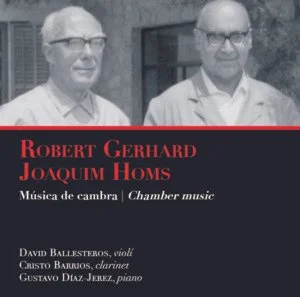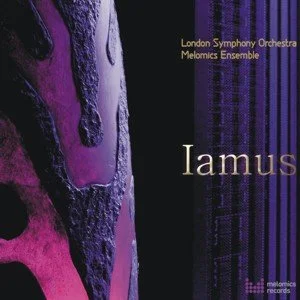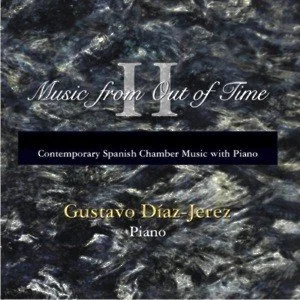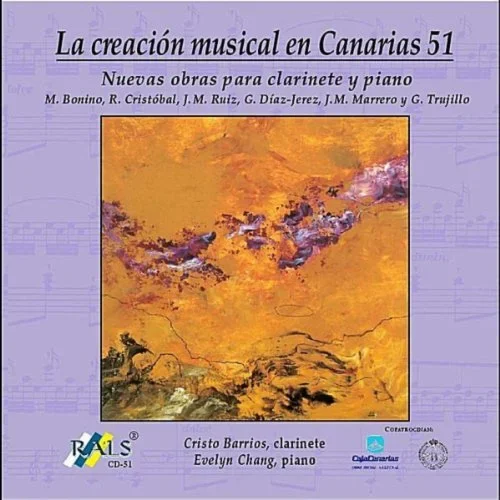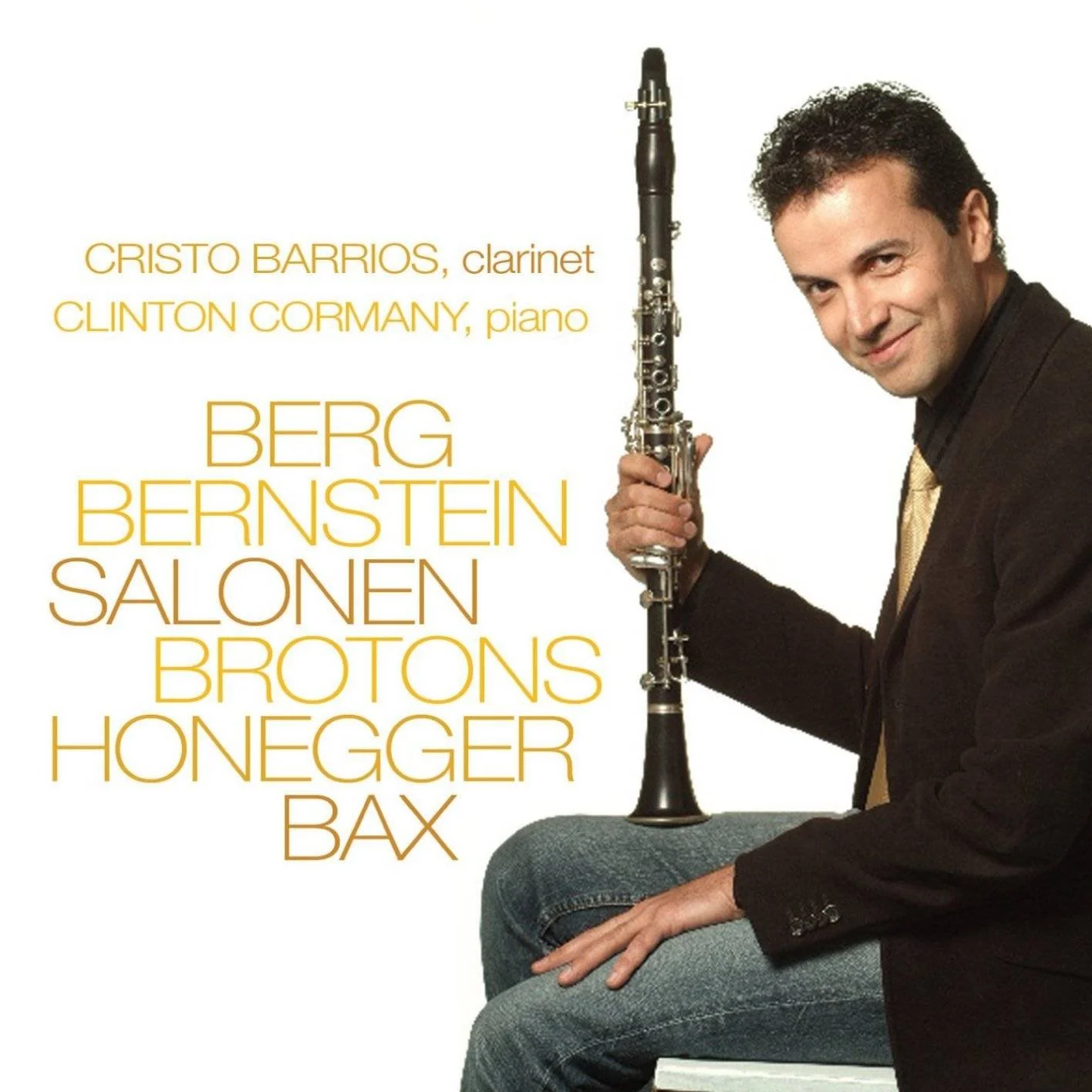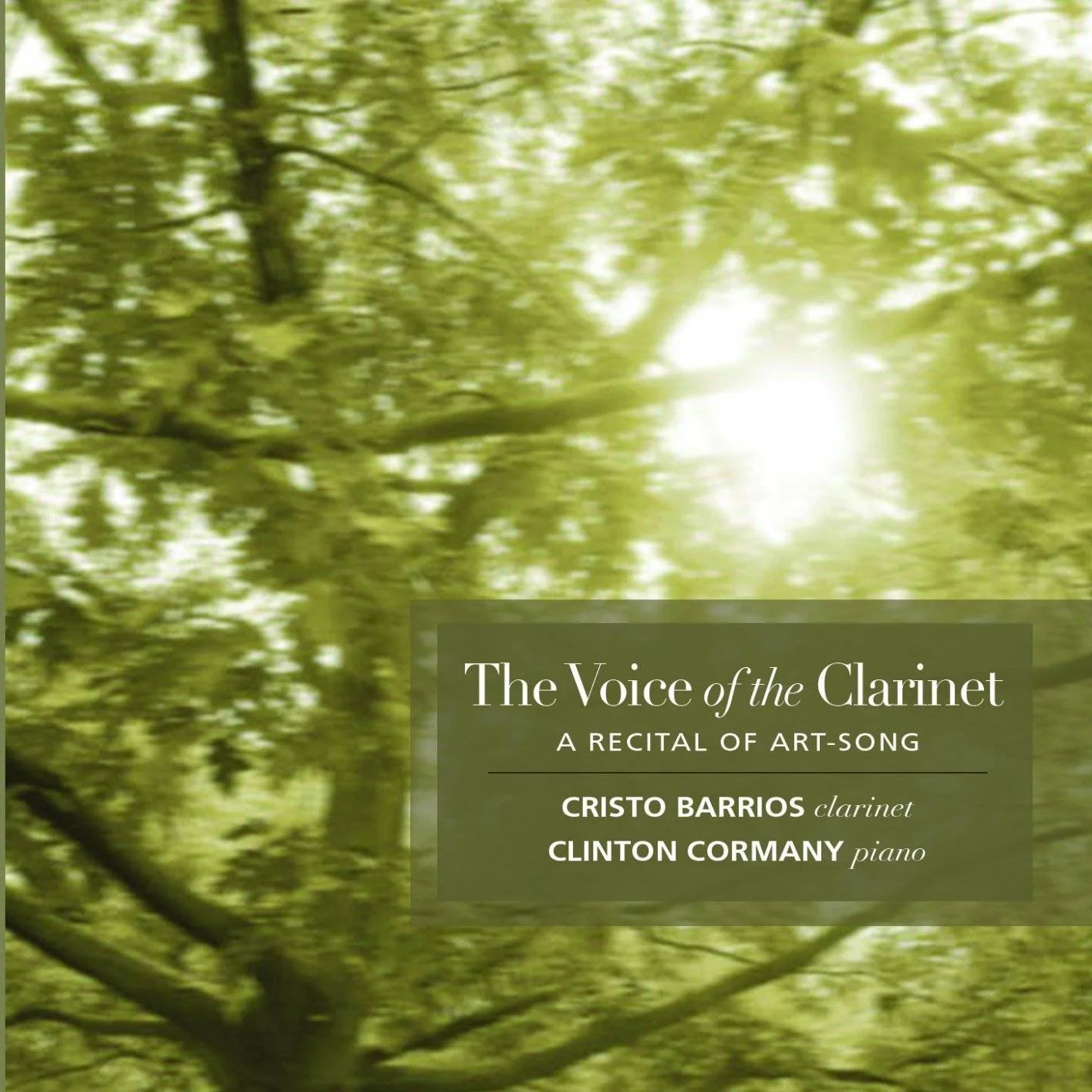Discography
Maghek
Gustavo Díaz-Jerez (n. 1970)
Ymarxa, Tenerife
Ayssuragan, La Palma.
Soloist: Cristo Barrios (clarinet)
Guanapay, Lanzarote.
Soloist: Ricardo Descalzo (piano)
Chigaday, La Gomera
Azaenegue, Gran Canaria
Erbane, Fuerteventura
Aranfaybo, El Hierro
Gustavo Díaz-Jerez, composer
Royal Scottish National Orchestra
Eduardo Portal, conductor
Cristo Barrios, clarinet
Ricardo Descalzo, piano
This album represents the culmination of more than ten years of composition work by Gustavo Díaz-Jerez. It comprises seven symphonic poems evoking the landscapes and natural beauty of the Canary Islands. The cycle takes its name, Maghek (“who creates light”), from the sun goddess of the Guanches, the aboriginal inhabitants of the Canary Islands.
Ayssuragan, symphonic poem for clarinet and orchestra, is part of this ambitious creative project. It is a composition in which somewhat complex tools come together, such as elements of the spectral compositional current and procedures related to mathematics and computing. The work allows us to experience aspects of the nature of sound that are difficult to access otherwise. On the other hand, this concert is emphatically melodic, timbral, sweet and, at times, fast-paced. Thus, although it may seem paradoxical, Ayssuragan has, on the one hand, a highly original facet that makes the listener enjoy an unusual musical experience; however, on the other hand, it presents an accessible and direct musical discourse.
The Scottish National Symphony Orchestra, Eduardo Portal (conductor), Richardo Descalzo (piano) and Cristo Barrios (clarinet) participated in this project. The project was financed by the BBVA Foundation (Leonardo scholarship), the Government of the Canary Islands, El Cabildo de Tenerife and El Cabildo de Gran Canaria.
Text by Cristo Barrios
Reviews
“The clarinet, played with virtuosity by Cristo Barrios, is allowed to gallop wildly across Ayssuragan, to dream softly in between, to be pampered with a few lyrical notes by the English horn, to chirp in competition with the flute, and then to be carried by the orchestra again and again.” (DAS ORCHESTER).
“The mysterious Ayssuragan (La Palma), with solo clarinet splendidly served by clarinetist Cristo Barrios.” (Tomás Marco para SCHERZO)
“Here it applies to the spirit of desolation and ghostliness imparted throughout by Cristo Barrios, an excellent soloist whose playing is bold and sensitive by turn.” (MUSICWEB INTERNATIONAL)
“In this concerto, the solo clarinet seems to simply emerge from nothing, creating at first an intimate, yet sombre sound world where the clarinet’s keening seems to relate to the narrative of what happened on the island. By the end, we have been on a journey with Barrios demonstrating both poetry and virtuosity in the solo part.” (PLANET HUGILL – A WORLD OF CLASSICAL MUSIC)
Deep Light
Carl Maria von Weber (1786-1826)
Gran duo concertant op. 48
Gerald Finzi (1901-1956)
Five Bagatelles
Ralph Vaughan Williams (1872-1958)
Six Studies on English Folksongs
Robert Schumann (1810-1856)
Fantasy Pieces Op. 73
Jean Françaix (1912-1997)
Theme and Variations
Cristo Barrios, clarinet
Andrew West, piano
We were inspired to gather together this collection of chamber works for reasons beyond the obvious prestige of the individual composers and the importance of their works. We wanted to present the listener with a satisfying musical journey, as much through the formal variety as the expressive content of the pieces. The contrasts are to be found among different movements of the same piece, as well as among the five works on the recording.
Rather than offering a historical overview of the programme, we would prefer to look briefly at our choice of title, Deep Light, and its various meanings. On the one hand, it aims to evoke the luminosity that lies in the depth of feeling, represented here by two major works of the German Romantic clarinet repertoire, the Grand Duo Concertant by Carl Maria von Weber, and Robert Schumann’s Fantasy Pieces. Emotionally profound in their darker, slower movements, these works also display an exalted brightness in their exuberant finales. On the other hand, however, the deep and the light are simply synonyms for the serious and the playful. Seen in this way, the two German works provide the weight on the CD, while the three others fall more into the second category.
It is our hope that the contrast in styles, and the unusual juxtaposition of repertoire, will stimulate those familiar with these works into fresh ways of listening, and provide those new to them with the delight of discovery.
Text by Cristo Barrios and Andrew West
Reviews
“The interaction between the two musicians is perfect. It is an essential disc for any music lover.” (MELÓMANO). NOTE: this album was distinguished with the “Melómano GOLD”
“Barrios plays with a pure tone and lots of technique.” (FANFARE MAGAZINE)
“What an exciting listen this is. Superb programming of clarinet works by primarily Engligh and German composers, with intimate sound and fobulously controlled playing.” (BBC MUSIC MAGAZINE)
“Right out of the box this sounds like classic Living Stereo and Masterworks recordings both in heart and in soul.” (MIDWEST)
“This outstanding CD from IBS Classical [...] The virtuosity of the present soloists is obvious from the first to the last bar. Both survive the tremendous complexities of this piece with assurance [...] The duo plays them with great skill and a tender enthusiasm.” (MUSICWEB INTERNATIONAL)
“The gift of sensitivity and refinement must be possessed, as the case may be, to arrive at such a result of subtlety and refinement.” (RITMO)
“Barrios and West certainly more than convince in these gentle, evocative yet highly expressive performances. In particular, Barrios makes the emotions implicit in the music come over well without overdoing things”. (PLANET HUGILL)
“Barrios is surprisingly good: [a performance] very cleverly colored and gifted with the right intuition for every mood. He understands the different components that make up each character, with which he achieves an extremely pleasing result.” (DE KLARINET)
Roberto Gerhard and Joaquim Homs. Chamber Music
Robert Gerhard - Study for the movie Secret People for violin, clarinet and piano (1952)
Joaquim Homs - Soliloqui for clarinet solo (1972)
Joaquim Homs - Impromptu for violin and piano
Robert Gerhard - Sonata for clarinet and piano (1928)
Robert Gerhard - Dos apunts for piano solo (1922)
Joaquim Homs - Dues invencions for clarinet and piano (1963)
Joaquim Homs - Sonata for violin solo (1941)
Robert Gerhard - Andantino for violin, clarinet and piano (1929)
Joaquim Homs - Trio for violin, clarinet and piano (1974)
David Ballesteros, violin
Cristo Barrios, clarinet
Gustavo Díaz-Jerez, piano
All Homs’ works featured in the present programme are representative of his music and, especially so, insofar as they are chamber pieces in which his marked sensitivity becomes even more evident. The same cannot, however, be said of Gerhard, whose musical production was fragmented by the circumstances of his life. The Andantino and the Sonata for clarinet and piano are pieces he most probably composed in Berlin during his student days and whose manuscripts are preserved at the l’Institut d’Estudis Vallencs. Although we actually know little about them, it would seem that they were intended for more ambitious, longer works that were never finished. His study for the film Secret People is a sample piece, presented with a view to a potential commission, in which he exposes the two main themes he intended to use for the soundtrack. Although these works are hardly representative of Gerhard’s personal style, they cannot be ignored, as they serve to demonstrate his professionalism and expertise. Gemini, for violin and piano, on the other hand, forms part of a period of greater maturity and creativity in the composer’s life and provides us with a perfect image of the great Gerhard. Composed in 1966, it was released the same year with the title Duo Concertant. It consists of a series of contrasting intertwining episodes which greatly exemplify the polymorphic concept of his final years. Although it is a concertante piece, it does not prioritize the virtuosity of its performers, but rather the quality of sound based on a lush variety of registers, with poignant piano passages combined with the long notes of the violin and vice versa.
Text by Josep Mª Mestres Quadreny
Reviews
‘The value of this recording by Barrios, Ballesteros and Díaz-Jerez is unquestionable by their understanding of the style and for their intelligent use of technique and expressive resources’. (MELÓMANO MAGAZINE)
‘Columna Música presents here a brilliant performance of a not well known repertoire by Homs and Gerhard’ (SCHERZO MAGAZINE)
‘Homs’s 1972 Soliloquy for solo clarinet is representative of his work in a way that the disparate. It’s very finely organised and performed.’ (MUSICAL WEB)
‘Keep an eye on this new CD release, not only because it’s wise and successful performance but also because of its idea and concept.’ (440 CLÁSSICA)
IAMUS
Tránsitos: 1. Rumor de espejos, 2. A un abismo for symphony orchestra
Nasciturus for viola d’amore and harpsichord
Alphard for solo clarinet
Kinoth for violin and piano
Colossus for piano
Hello World! for violin, clarinet and piano
Ugadi for violin
Mutability for soprano and piano
Gustavo Díaz Jerez, piano and harpsichord
Celia Alcedo, soprano
David Ballesteros, violin
Cristo Barrios, clarinet
Sviatoslav Belonogov, viola d’amore
Cecilia Bercovich, violin
Borja Quintas, conductor
London Symphony Orchestra
Melomics is a research project promoted by the University of Málaga, partially funded by the Spanish Ministry of Economy and Competitiveness. Iamus, a computer which is able to make contemporary classical music, has been developed as part of the project. The main innovations of Iamus are that it can create scores in standard music notation and its pieces are indistinguisable from those created by human composers. A biomimetic approach has been used to program Iamus, in which each composition develops from its genome (imitating multicellular beings) evolving towards compositions of increasing complexity and beauty. This evo-devo approach is among the most promising methonds in the field of Computational Intelligence.
Text by Dr. Francisco J. Vico (PI of the Melomics project. Group of Studies in Biomimetics, University of Málaga. Spain).
Reviews
‘When computer scientists start messing with music, their electronic sounds rarely elicit much interest beyond the research lab or the experimental basement club. So it was a milestone last April when the London Symphony Orchestra recorded “Tránsitos”, a 13-minute work by Iamus, a computer developed by Francisco J. Vico at the University of Málaga in Spain.’ (DISCOVER Magazine)
‘As soon as you see the title of Iamus’s composition Transits – Into an Abyss, you know it’s going to be challenging.’ (THE GUARDIAN)
‘Until now – programmers at the University of Malaga have developed Iamus, which is able to create compositions without the aid of human intervention. Several of these have been deemed good enough to be performed by top orchestras and musicians.’ (THE TELEGRAPH)
‘The Melomics Ensemble performed the rest of the pieces, the vocal and instrumental ones, solving naturally all technical problems.’ (RITMO Magazine)
Music from out of Time II
Gustavo Díaz-Jerez (1970) - Gehenna. Two Reflections for piano solo after Gustave Doré (2004)
José Luis Turina (1952) - Dos Duetos for viola and piano (1994)
Laura Vega (1978) - Laberintos for clarinet and piano (2010)
Mikael Trillo-Figueroa (1978) - Unrevealed Cube 4×4 for piano trio. An Unsolved Riddle (2009)
David del Puerto (1964) - Dolce for clarinet and piano (1998)
Gustavo Díaz-Jerez (1970) - Tephra for violin, viola, violoncello and piano (2008)
Gustavo Díaz-Jerez, piano
Cristo Barrios, clarinet
Savva Fatkulin, violin
Cecilia Bercovich, viola
Ángel García Jermann, cello
Laberintos. The work was inspired by the poem of Belinda Sánchez, “Hope is not a word of poets…” The powerful ideas acquire their meaning from extra musical elements contained in the text, endeavoring to transmit the sensations and feelings the words suggested to me, words loaded with a certain sadness and desperation. Moreover, and in a much camouflaged way, the motivic materials originate from the harmonic and melodic Chorus, Ah holy Jesus, how has thou offended, from J.S. Bach’s St. Matthew Passion. Laberintos is developed in one movement, sub divided into sections of very diverse textures and sounds, on occasions, constant, although they largely originate from the piece´s initial motif. The musical material, used in some cases as a “sound mass”, evolves and transforms itself as if trying to recreate a journey through a multiform labyrinth which springs a surprise at every turn. The labyrinth is used as a musical construction and as a symbol of the human condition reflecting the infinite circumstances of life easy to enter into but at times impossible to get out of. Below is the crossroads of the composer and poet in the process of their new work…
Dolce is a fantasia in which a wide variety of rhythmic ideas are subjected to a limited number of harmonic elements, essentially reduced to two cells with four sounds. These cells act somewhat as filters which modulate the material. The work constantly oscillates between fluidity and rhythmic precision, presenting musicians with a very demanding discourse, which must jump, at any given moment, from placidity to rigor, from the flexible, dreamy ambience, alluded to in the title, to the rhythmic and stricter contrapuntal games, with much harsher
edges, and this demands great versatility of character and color. This work, dedicated to my friend the composer and musician Javier Arias, was to all intents and purposes the beginning of a harmonic work which was of crucial importance for my subsequent works. For this reason, Dolce can justly be considered as the starting point of an adventure with huge consequences for my music.
Reviews
‘When computer scientists start messing with music, their electronic sounds rarely elicit much interest beyond the research lab or the experimental basement club. So it was a milestone last April when the London Symphony Orchestra recorded “Tránsitos”, a 13-minute work by Iamus, a computer developed by Francisco J. Vico at the University of Málaga in Spain.’ (DISCOVER Magazine)
‘As soon as you see the title of Iamus’s composition Transits – Into an Abyss, you know it’s going to be challenging.’ (THE GUARDIAN)
‘Until now – programmers at the University of Malaga have developed Iamus, which is able to create compositions without the aid of human intervention. Several of these have been deemed good enough to be performed by top orchestras and musicians.’ (THE TELEGRAPH)
‘The Melomics Ensemble performed the rest of the pieces, the vocal and instrumental ones, solving naturally all technical problems.’ (RITMO Magazine)
Nuevas obras para clarinete y piano
Manuel Bonino - Metaimpromptu
Raquel Cristóbal Ramos - Sonata for clarinet and piano
Juan Manuel Ruiz - Bentayga
Gustavo Díaz Jerez - Three pieces for clarinet and piano
Juan Manuel Marrero - Insolence
Gustavo A. Trujillo - Lamento del Alba
Cristo Barrios, clarinet
Evelyn Chang, piano
This CD was an idea of Cristo Barrios. It also came to reality because of him. He commissioned six pieces for clarinet and piano to six Canarian composers, three from Tenerife and the other three from Gran Canaria. It is not very common to find performers showing so much enthusiasm for contemporary music, being worried for the local composers, although this situation is changing. Cristo Barrios is among those performers, because he is an open, versatile musician, full of curiosity about the musical thought of his time. He has played with his awesome sound, full of colours, and his precise sense of rhythm, in many important national and international venues, bringing always many music of the XXth and XXIst Centuries, contributing to bring unkown names to the fore. This curiosity and interest show a singular musician, who founded a good partner in Evelyn Chang, at the piano.
With this CD, RALS Project shows a new facet, chamber music, open a new path for the repertoire of clarinet and piano, presenting six pieces by Canarian composers, who already enjoy solid careers. The variety of thought included in this CD, speak by themselves about how far musical creation has reached in the Canary Islands.
Written by Rosario Álvarez (CD booklet)
Reviews
‘I think this CD is fantastic. Congratulations! The performances are just brilliant!.’ (Manuel Marrero
– featured composer)
‘Great! Congratulations!’ (Raquel Cristobal – featured composer)
‘It is a luxury to work with you. I want to congratulate you for this excellent work and for your enthusiasm and dedication.’ (Manuel Bonino – featured composer)
‘Fantastic work. I am very happy with the final version of ‘Bentayga’, an astonishing performance full of precision and expressive power.’ (Juan Manuel Ruiz – featured composer)
‘Great, many thanks! It sounds really nice, and I love the timing between the slow and fast sections.’
(Gustavo Trujillo – featured composer)
‘In this CD Cristo Barrios shwos perfectly his beatiful sound, absolute control of dynamics in all registers, a very fine articulation and an extraodinary phrasing. Canarian composers should be proud of this new album.’ (Gustavo Díaz Jerez – featured composer)
XXth Century music for clarinet and piano
Leonard Bernstein (1918-1990) - Sonata for clarinet and piano (1941-42)
Salvador Brotons (b. 1959) - Sonata for clarinet and piano Op. 46 (1988)
Alban Berg (1885-1935) - Vier Stücke for clarinet and piano (1913)
Arnold Bax (1883-1953) - Sonata for clarinet and piano (1934)
Esa-Pekka Salonen (b.1958) - Nachtlieder for clarinet and piano (1978)
Arthur Honneger (1892-1955) - Sonatina for clarinet and piano (1921-22)
Cristo Barrios, clarinet
Clinton Cormany, piano
The twentieth century was very good to the clarinet. The popularity of the instrument with composers of the modernist and postmodernist eras was in fact a culmination of its flourish during the nineteenth century (due in turn to its being singled out in the eighteenth century by one Wolfgang Amadeus Mozart). Established by the time of Beethoven’s death as a viable concerto and chamber-music participant, the clarinet passed through the hands and hearts of Romantic composers like Weber, Mendelssohn, Saint-Saëns, and Brahms to become an important sonata instrument alongside the violin and the cello.
The present disc is an exploration of abstract clarinet-and-piano music after Brahms’s superlative op.120 Sonatas of 1894 for this coupling. The six items on this programme include three sonatas, one sonatine, a set of pieces which taken together closely resemble a sonata, and another set inspired by the latter. All six might be considered to be rather off the beaten recital-programme path and all six convey something of their national origins. Certainly all have retained particular currency in their composers’ respective countries.
Written by Daniel Montclair
Reviews
‘This wide-ranging collection of works for clarinet and piano makes a superb showcase for the prize-winning clarinettist Cristo Barrios. His tone is not just beautiful but finely graded over the widest dynamic and expressive range.’ GAMOPHONE MAGAZINE
‘…the important issue here is his serene tone, impeccable phrasing, his virtuosity without exaggerations and his characteristic timbre. This immaculate CD that we present here is dedicated to the music for clarinet and piano after the great Brahms clarinet sonatas.’ MELÓMANO MAGAZINE
‘A nice recital for clarinet and piano, the material ranges from Bernstein to Berg and beyond. These two pros are on top of their game and can make this basic instrumentation sound like a lot more. One of the engaging points of this set is the material is well of left of warhorse repertoire giving the listener something sort of new as well as a new perspective. Charming in its deceptive simplicity, the best cats always make it look easy.’ MID WEST RECORD
‘This compilation of 20th century music for clarinet and piano draws together works infused with melody, such as the Bernstein and Bax sonatas, with the atonal qualities of Alban Berg’s work and its close associations with the so-called ‘Second Viennese School’. If you want an album to play while you’re doing other things, you might skip the Berg tracks. But even if the mere mention of the word ‘atonal’ makes you shudder, I would advise you to return to the Berg when you can give it your undivided attention. The piece by conductor/composer Esa-Pekka Salonen is also a work that demands close listening. Great playing!’ CLASSICAL FM MAGAZINE
‘In the lower registers Barrios has a wonderfully rich tone and he is an alert, sensitive player who knows how to make new audiences for his instrument, as well as for this repertory.’ INTERNATIONAL RECORD REVIEW
‘Barrios really brings out the lyrical side of the music…In the very fast, helter–skelter scherzo he lets go and really relishes the challenges the composer has given him. The quiet ending is quite magical. With such fine playing every piece comes alive and speaks in its own voice as music which has grown from a tradition and is continuing it into the next generation. Most enjoyable.’ MUSICWEB
‘A nice balanced programme to extend 20 C clarinettists’ repertoire, without venturing too far into extended techniques etc…All well played and recorded by Simon Fox at the Conservatoire of the Canaries, October 2007. I hope to give this CD to my local Conservatoire, Trinity College of Music, where some student clarinettist might pick it up for exploration?’ MUSICAL POINTERS
‘Spanish clarinettist Cristo Barrios is definitely a terrific talent on the clarinet; his sound is silvery, the voice of the instrument is free, and he has a wonderful sense of dramatic timing…The sound is warm and responsive…Cristo Barrios is definitely a clarinettist to keep an eye on.’ ALL MUSIC GUIDE
‘Bravo. Beautiful CD. I especially congratulate you for bringing the Sonata of Salvador Brotons to more listeners. Finishing with Honegger was delightful with your brilliant colleague, Mr Cormany. Very interesting performances and program. You should be proud.’ (Richard Stoltzman)
‘Your performances, sound and balance are sensational. Especially my sonata sounds amazing: tempi, expressive flexibility and brilliance. The last movement fits perfectly. Congratulations also to your superb pianist as you both sound truly like a duo throughout the CD.’ (Salvador Brotons)
‘I loved your CD and how you play, your sound, the repertoire, I enjoyed everything! These pieces by Alban Berg that I like so much! How nice!’ (Marielle Labèque)
‘I greatly enjoyed your recording!’ (Esa-Pekka Salonen)
‘Spanish clarinettist Cristo Barrios is definitely a terrific talent on the clarinet; his sound is silvery, the voice of the instrument is free, and he has a wonderful sense of dramatic timing…The sound is warm and responsive…Cristo Barrios is definitely a clarinettist to keep an eye on.’ (www.allmusic.com)
The voice of the clarinet
Grieg: Ein Traum - Caccini: Amarilli, mia bella - Vaughan Williams: The Roadside Fire - Sibelius: Var det en dröm? - Rimsky-Korsakov: The Nightingale sings to the rose - Duparc: L’invitation au voyage - Brahms: Kommt dir manchmal in den Sinn - Ravel: Pièce en forme de habanera - Strauss: Cäcilie - Falla: Asturiana - Rossini: La fioraia fiorentina - Wolf: Auch kleine Dinge - Schubert: Gretchen am Spinnrade - Debussy: Beau soir - Porter: Just one of those things - Rachmaninoff: Daisies - Poulenc: Les chemins de l’amour - Schumann: Requiem - Haydn: Piercing eyes - Fauré: Les berceaux - Obradors: Coplas de Curro Dulce
Cristo Barrios, clarinet
Clinton Cormany, piano
Since the days of isorhythmic motets (the Middle Ages, if you were wondering) instruments have stood in on vocal parts, but one might wonder if nowadays a clarinet can or should take on sung music like the Lieder repertoire. But why not? There is, after all, a long-standing flautists’ tradition of snapping up the songs of Schubert and others for their own uses, so why should a clarinettist who wishes to wax lyrical resist? Cristo Barrios is such a clarinettist (who did not resist): his album of twenty-five art-song transcriptions, entitled The Voice of the Clarinet, is scheduled to be released later this year by Divine Art Records. ‘The Voice of the Clarinet is a very personal experiment, something very special,’ he says thoughtfully, ‘and to my knowledge there hasn’t appeared a disc like it before.’
The pianist on the disc is Clinton Cormany, whom Barrios met in London at the Royal Academy of Music where they were both postgraduate students. Right from Academy days it seemed inevitable that they would explore the world of song as they continued to play together.
The selections on The Voice of the Clarinet represent some four centuries and a good many corners of the Western world. Some instantly familiar songs were chosen both for their value as well as their novelty on clarinet, a mere taste of American jazz is given (Cole Porter as consummate composer of art-song) and some rather more uncommon territory is toured. Many of these musical realisations of poetry manage to elicit what can only be called clarinet essence. But how do the songs get on without the words?
Written by Daniel Montclair
Reviews
'In this vein, the transcriptions are well done, and Cormany’s playing mirrors his vast experience as a vocal accompanist. Barrios, a former student of Richard Stolzman, bears much of his teacher’s passionate musicianship.' AMERICAN RECORD GUIDE
'The clarinetist has a glinting tone that mirrors the silver-on-black of his instrument.' NJ.COM
'This is a feast for those addicted to the liquid legato of the clarinet. The hero here is Cristo Barrios and his accomplished partner is Clinton Cormany. Together they put forward a largely delightful collection.' MUSICWEB
'There is lots of lovely, even cosy, deliquescent melody around. Cristo Barrios makes a nice individual sound and has great breath-control; and I am sure he has absorbed all the texts, which are generously printed in full in the booklet. There is no shortage of beautiful moments, and even surprises.' INTERNATIONAL RECORD REVIEW



